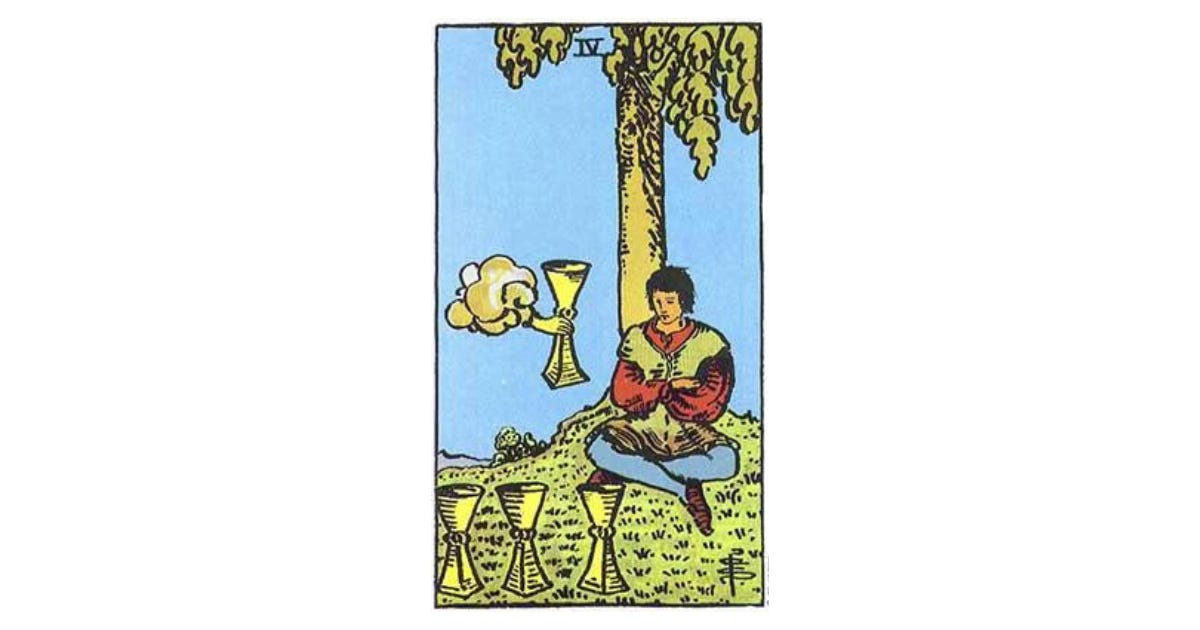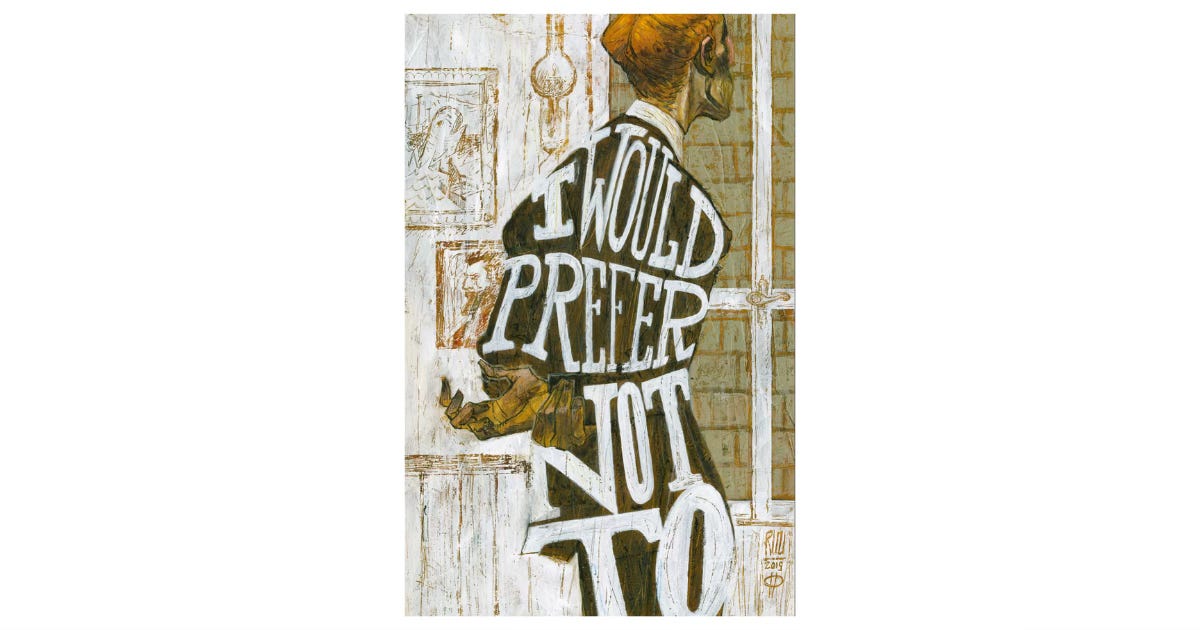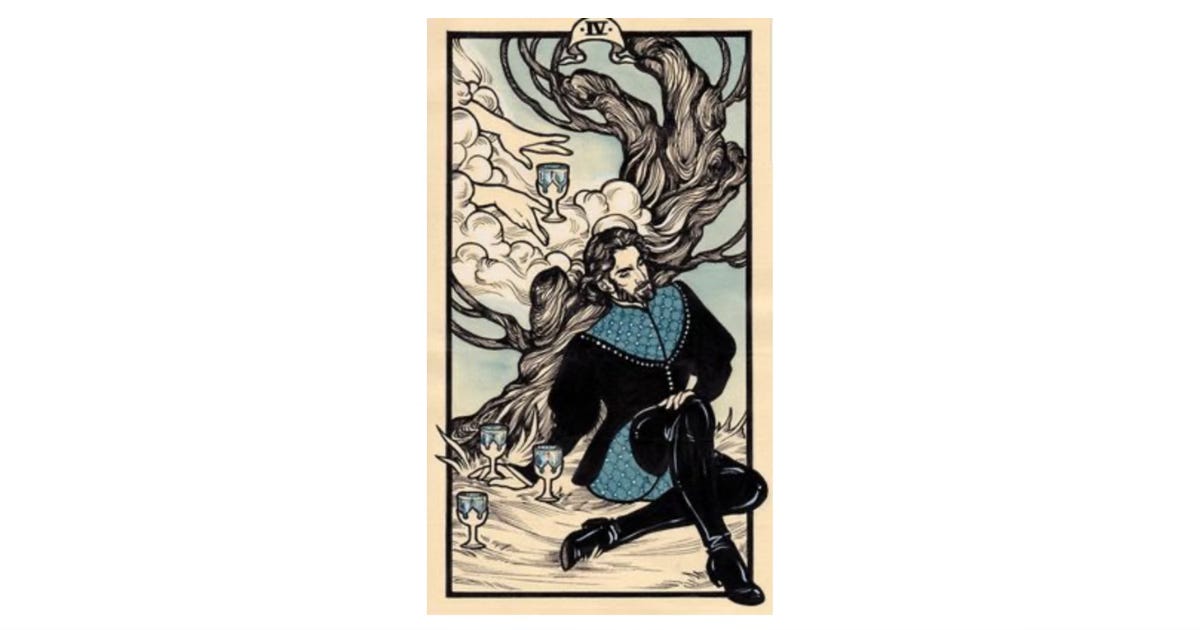3. Write Your Life with Tarot — Four of Cups
Waiting, wishing, resisting, reflecting...
First, 2 Announcements —
Hey, readers! I’m a hater who thinks Black Friday should be abolished, but I’m grateful you’re here and generosity is part of my business model, so for the next week, until November 30, which does include Black Friday, annual subscriptions to this newsletter are 20% off. This gives you full access to all the writing I share here — for $52 (instead of $65). You can upgrade your subscription and redeem this offer here, just in time to get December’s Tarot-scopes! I promise to share this offer again periodically (at times that do not coincide with Black Friday!). 😎
Also coming soon… I’m opening the doors to the Creative Magic Collective in the very near future! This is our nonlinear learning community for Creative Spirits & Mystics. We have weekly gatherings for journaling, creating, or studying Tarot, plus a monthly workshop on a creative or magical craft, often with wonderful guest teachers! Plus a big ole learning library, a one-on-one session with me, and a copy of my workbook Tarot for Creative Spirits! Read more about the Collective here, and join the waitlist here (and soon!) to receive first notice and the best bonuses!
The Four of Cups: Distrusting, Distant or Discerning?
This card has always been enigmatic to me. Is the human seated at the base of the tree crossing their arms and closing their eyes doing so with defiance? With indifference? Is this a moment of refusal? A moment of discernment? Or both?
The cups, of course, deal with the realm of feelings and emotions, which move and flow through our physical bodies (our nervous systems and muscle and flesh) like water, like waves crashing against the shores of Self, then receding like the tides.
This means the question at the center of the Four of Cups is one of feeling. What feeling creates the calm “no, thanks” emanating from this human on the hillside seeking shade and solace?
If you’ve ever read the “Bartleby, the Scrivener” by Herman Melville, this is the Tarot card for that story (or part of that story). In looking up “Bartleby” again — I haven’t read it in awhile, but I’ve read it several times — I learned the subtitle is “A Story of Wall Street,” and Bartleby is absolutely caught in an existential crisis of Capitalism’s design.
The story was published in 1853, before the Civil War, and serialized in two parts in Putnam Magazine. In the story, an established lawyer is able to expand his staff from two to three, so he hires a new scrivener, Bartleby. At first, Bartleby works hard and lives up to his boss’s hopes. But one day, Bartleby stops doing what he’s told and starts declining the tasks assigned to him.
When the lawyer, or a coworker, gives Bartleby something to do, he responds by saying, “I would prefer not to.” That’s his line. Over and over again. As the story goes on, Bartleby works less and less — he would prefer not to — but he remains in the office, nevertheless, spending much of his time staring out the window. No one really knows what to do with Bartleby or how to get through to him. Bartleby starts sleeping in the office overnight and gradually sort of takes over the building, like some anti-capitalist troll.
The story ends pretty bleakly (guess what, Capitalism wins again!), but Bartleby’s polite, understated, simplified resistance feels very alive in the Four of Cups. And quite admirable in the confines of Wall Street, the seat and envy of American Capitalism.
Though the story is told from the point of view of the boss, any working-class reader who’s spent more time in the employee pool than the C-suite identifies with Bartleby, who, through his repeated statement of preference (or anti-preference), prompts us to ask ourselves: What would I prefer not to do? What would it be like to turn ‘I prefer not to’ into a mantra for myself, even for 48 hours?!
American (and global) Capitalism makes sure there’s something just around every corner, on the other side of every bathroom break, every glimpse at your phone — a new product, treat, request for assistance, emotional demand, meeting, errand, fire to put out… If we never refuse, we’ll end up like 10 of Swords (as Bartleby does, I hate to say it).
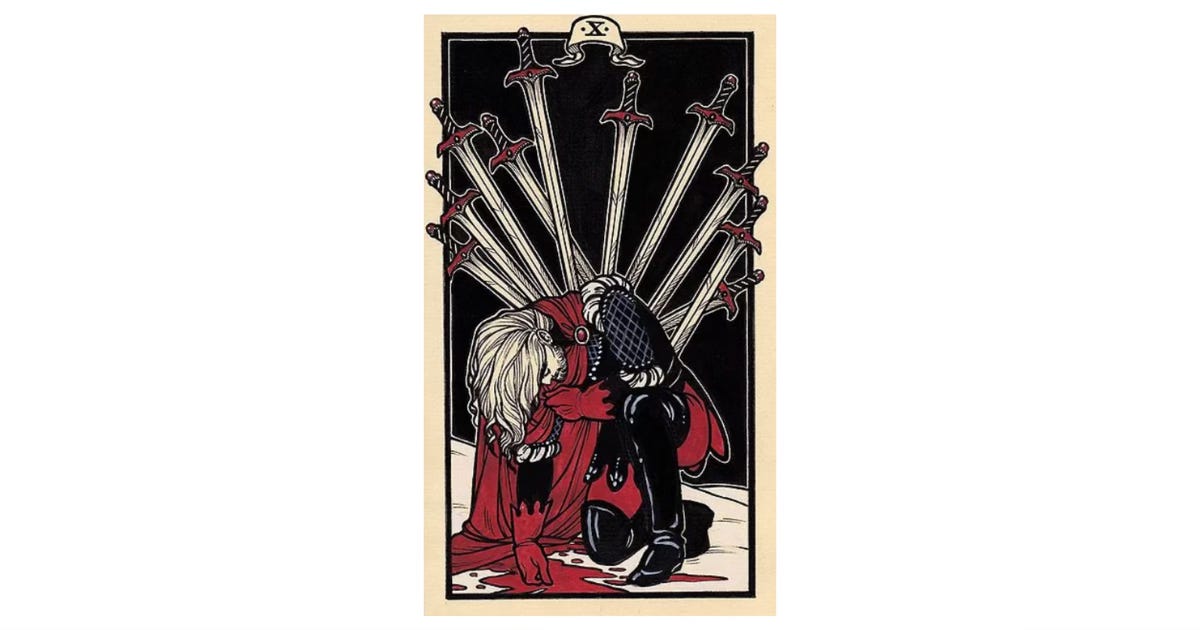
Four of Cups helps us perform an internal systems check before we act. It says: You have three cups already, do you want a fourth? Do you need it? Where is the edge of your capacity, your desire, and how can you manage not to stray beyond it? If you weren’t trying to please anyone but yourself, what would you choose? Maybe there are four different parts of you with four different responses to these questions, but that’s why we take a moment to pause and listen while the interested parties weigh in.
My grandmother Celeste, who inspired this series (read that tale here), made a habit of doing something I only really noticed in recent years. I had to get older to appreciate the skill and rhetorical move she was making, but she did it often enough that my memory retained it. Often when someone proposed something or asked for something or suggested that something be done, Granny would say, “Well, let’s think about that for a minute…” In my memory, she often would then sit down at a kitchen table and think out loud about it, weighing the request against other plans and time constraints.
Maybe it was a strategic move to help her petitioners come to a conclusion she found amenable while also helping them feel like they arrived at that conclusion themselves, or at least in collaboration. It worked, in part, because no one laid down a definitive NO, and each request was given due consideration. But either way, she checked with herself first. She checked against what else she had going on, her priorities and commitments, and how much she could reasonably do in the span of a day.
In Red Tarot: A Decolonial Guide to Divinatory Literacy, Christopher Marmolejo sees the Four of Cups as a refusal of love, a pulling away, perhaps as a protective reflex after a previous love turned sour. But closing ourselves to love closes us off to life.
On the other hand, Marmolejo points out that perhaps The Thinker in Repose here is waiting for their intended, holding out for something promised them, saving themselves — their energy, their intellect, their heart — for the visitor who truly feels right, the one that feels like a FUCK YES.
Marmolejo quotes Jeffrey Wolf Green in Pluto: The Evolutionary Journey of the Soul:
Within the Soul there exist two coexisting desires. One desire is for separate existence — to separate from that which created the Soul. The other desire is to return to the Source of Creation. … Buddha’s enlightenment underneath the bodhi tree was based on just such a realization as he pondered the nature of sorrow, pain, and misery.
Marmolejo goes on to reflect:
The figure sitting under the tree of the Four of Cups is perhaps in such a state of meditation. Perhaps they are caught up in a hero complex, which requires their self-imposed alienation for the sake of safety. Like Superman, they fly high above the earth, listening so deeply from such a remote place, disconnected physically but extremely connected to the collective continuous connection. Perhaps they sit with a sense of guilt for the love they so abundantly possess, reluctant with the awareness of the world’s undeniable misery. Perhaps they are willing love to come where they are waiting. Perhaps they are hallucinating. Maybe the figure’s love lesson in this waiting game is discerning patience from punishment. “Not yet” is not “no” when waiting for the right one.
And so the figure in the Four of Cups seems both enlightened in one sense — aware of something important about their existential nature, their suffering — but also holding the weight of earthly concerns, the ego’s needs, the practical impulse to try and prepare for the future: Will [whatever is offered] be enough? Is it really worth it? Am I worth it?
One thing we can appreciate about this card is that it shows us how the Tarot IS — a bit mercurial at times, presenting us with more questions than answers, showing us the both-sides-ism of so many situations. Yes, maybe this tree sitter is lovelorn and withdrawn. But also maybe discerning and in need of retreat.
The answer is made in the reader, then. The one who sees themself in the card. Are we the spurned lover? A bored dilettante? Student of enlightenment? Practitioner of enough-ness?
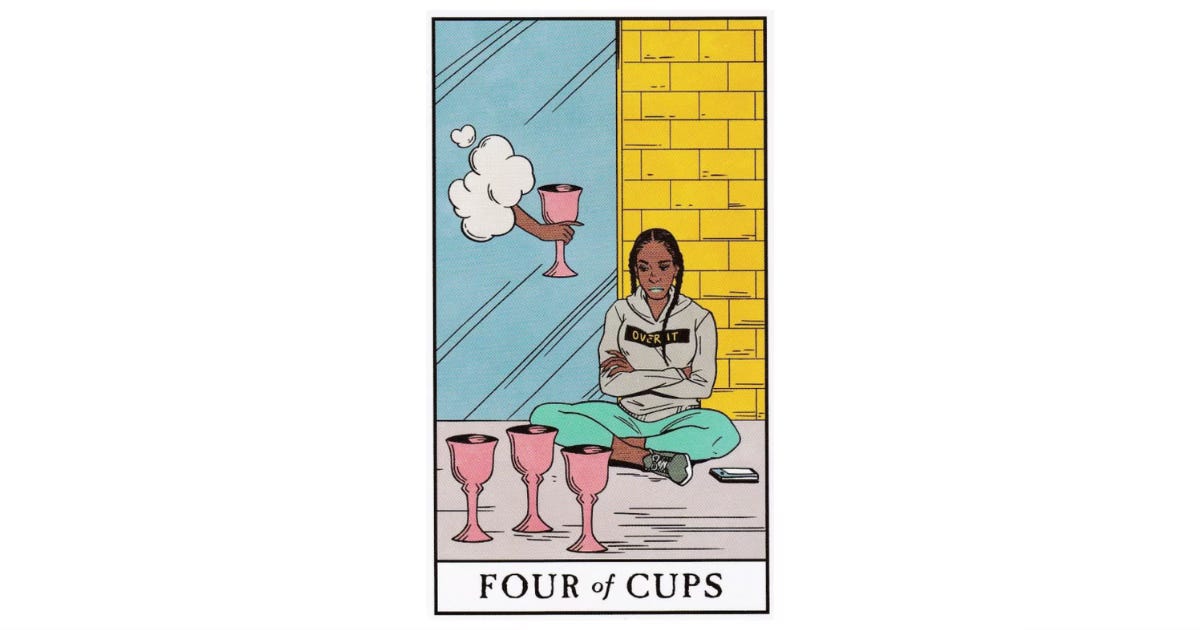
And so, here are FOUR prompts inspired by the FOUR of Cups to help you write about your life. I recommend reading them all and paying attention to what arises within you. Maybe nothing right away. Maybe a slight aversion or curiosity or excitement. But perhaps wait — like the sitter in the Four of Cups — and see what stories begin rise to the surface. What memories are suddenly present and responsive, ready to be transcribed?
Writing Prompts for the Four of Cups
#1 — Have you ever said no to something, but wished later you’d said yes?
Keep reading with a 7-day free trial
Subscribe to Typewriter Tarot to keep reading this post and get 7 days of free access to the full post archives.



